Thrips are tiny flying insects that wreak havoc on plants. Houseplants, garden plants, and greenhouse crops are all infested with these common pests that feed on their sap and juices. Plants may lose their color and die as a result of thrip infestations. Getting rid of thrips is difficult. Before emerging to eat plants, their pupae lurk in the soil.
Unfortunately, the infestation is already serious if thrips are discovered on the underside of your houseplant leaves. Thrips pierce and suck sap from plants’ stems and leaves, causing damage. Female thrips deposit eggs in leaves, making it difficult to get rid of them.
The most successful techniques to get rid of thrips from plants are discussed in this article. It’s crucial to understand the life cycle of thrips in order to avoid them from returning, in addition to employing natural insecticides.
What are Thrips?

Thrips are members of the Thysanoptera family of tiny black, yellow, or tan-winged insects that may do tremendous damage to plants. thrips come in over 6,000 different varieties. While some thrips species are helpful, the majority of them are plant-eating creatures.
Most thrips are about 1–2 mm long, making them difficult to see. Thunderbugs, thunderblights, corn lice, and corn flies are some of the other names for thrips.
Thrips Plant Damage
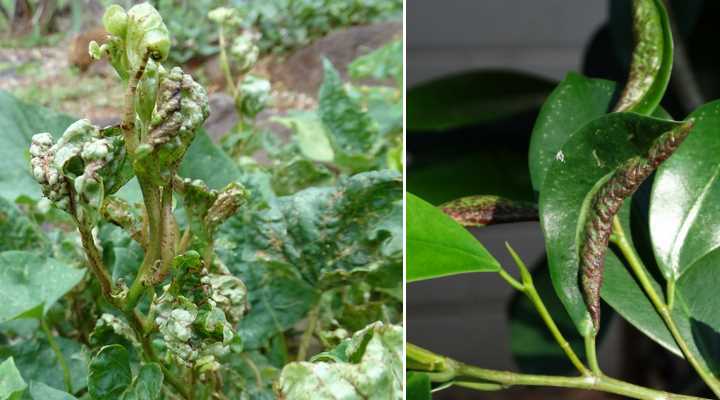
While thrips feed on the leaves and stems, they cause leaf damage. Thrips have piercing mouthparts that allow them to suck nectar from plants. Silvery-white spots and black dots are the symptoms ofThrips damage to plants. Plant damage may result in foliage becoming discolored and, eventually, death if you don’t exterminate thrips fast. Plants are damaged in a different way by thrips. Thrips spread severe plant diseases, causing damage to plants.
Impatients necrotic spot virus and tomato spotted wilt virus can both be spread by thrips. Wilting or stunted development, leaf blight, and plant death are all symptoms of these plant diseases. Greenhouse plants, garden plants, and houseplants can all be infected by thrips-borne plant diseases.
Roses, tomato plants, ornamental plants, monstera houseplants, orchids, fruit trees, and vegetables may all be damaged by thrips. The majority of plant damage is usually caused by insects in the Thripidae family.
What do Thrips Look Like?
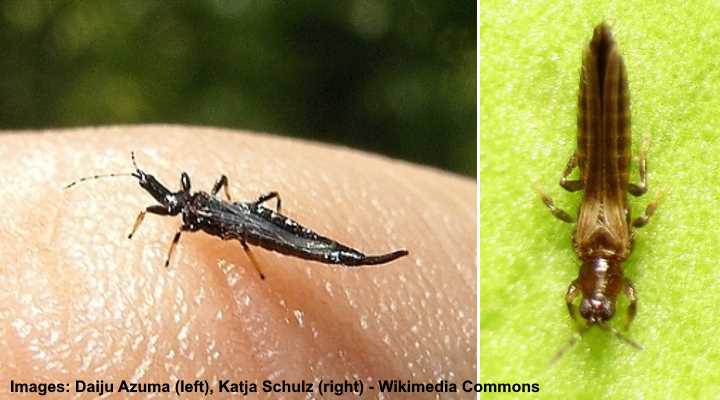
Thrips have black, yellow, or light brown bodies and have long, slender bodies. When disturbed, these sucking insects have fringed wings and fly away or jump. From 0.02″ to 0.55″ (0.5 to 14 mm), thrips come in a variety of sizes. The majority of thrips that attack houseplants are approximately 0.04 inch (1 mm) long. thrips are exceptionally difficult to find due to their tiny size.
Little black slivers hiding beneath leaves are a common sight for nasty creatures. Thrips look like tiny lobsters when seen under a microscope, and they may or may not have wings. Insects are less visible than thrip plant damage.
Put a white piece of paper beneath the leaves of your plant to determine if it has thrips. Tap the leaves firmly with your hands. The white paper will catch any nasty bugs that may be hiding underneath the leaves.
Where to Find Thrips on Plants
Thrips lay their eggs on the bottom of leaves and reside there. Little black, white, or yellow dots may appear at first as a thrip infestation. Thrips may sometimes be seen crawling on the underside of foliage or flying around it. Thrip eggs on leaves aren’t harmful to the plant, but they are a symptom of bigger issues to come.
The pupae fall into the ground and develop into adults after hatching. You may find a ‘new’ infestation after a few days, even if you think you’ve gotten rid of thrips for good.
What are the Signs of Thrips Infestation?

Small dark green or black specks on the bottom of leaves are one of the symptoms of thrips damage to plants. Little silvery patches develop in time, followed by bigger discolored stains. Leaves can wither, turn yellow, and curling at the edges as plant development weakens.
Leaves may develop sunken, discolored streaks depending on the species of plant. You may notice that thrips don’t develop into flowers if they have been feeding on buds. Infested plants may stop growing in severe cases.
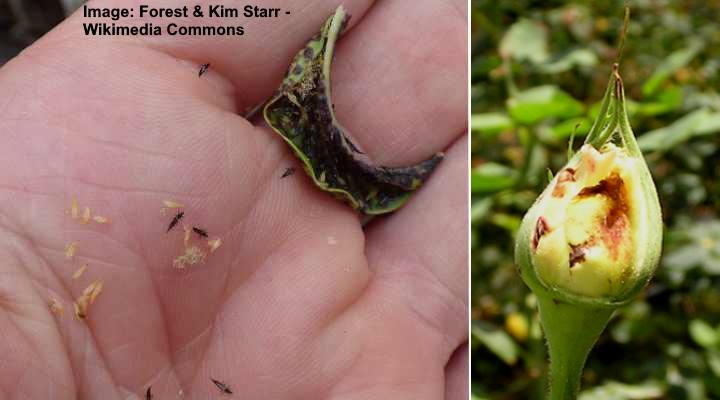
Another symptom of a thrip infestation is leaf galls or rose bud damage (right picture). The plant appears unappealing due to these little discolored elevated lumps. Galls form when thrips deposit their eggs in leaves, and a chemical is excreted that damages cells. You get leaf galls when the damaged cells replicate faster than they should.
Thrips Life Cycle
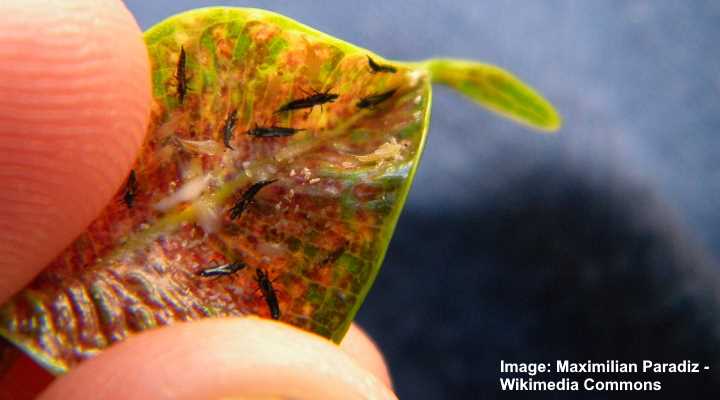
Thrips live for around 45 days, from eggs to adults. Thrips develop as tiny cylindrical eggs hidden in the plant’s soft tissue, much as other insects do. Before becoming pupae, thrips go through two larval stages. The pupae then fall to the ground and become adult insects. The thrip’s life cycle, from egg to adult, may take as little as 14 days in warm weather.
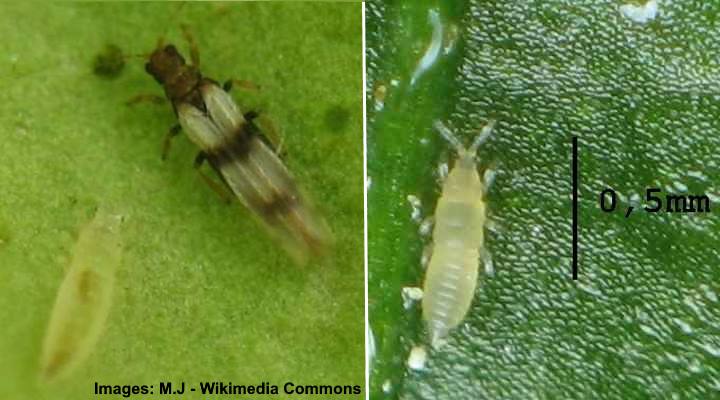
Know the lifecycle of thrips before you attempt to get rid of them from your plants. Even after treating a plant for thrips, there might still be microscopic pupae in the soil, so vigilance is required. They’ll return to feeding on the plant as soon as they hatch. And the cycle repeats itself from the beginning.
What do Thrips Eat?
Thrips puncture the leaves with their mouthparts and suck the liquid from them, feeding on plant juices. Discoloration of the leaves may be a result of this plant damage. Thrips have sharp jaws that may scar or deform developing fruit, and they eat a variety of fruits. Once they emerge from eggs, larvae eat the plant leaves.
Should You Use Pesticides to Get Rid of Thrips?
To get rid of thrips, it’s usually best to use non-toxic pest control methods. Pesticides are harmful to people and animals, and they need particular handling methods. Synthetic chemical insecticides may also develop resistance in houseplant bugs and thrips.
Thrips may be controlled with a variety of natural remedies, despite their difficulty in exterminating. Of course, it’s easy to think of chemical pesticides when you find bugs and insects on houseplants like thrips. They might seem to be a simple remedy for your pest problem in the home. Yet, using non-toxic approaches, there are several effective ways of removing thrips.
How to Get Rid of Thrips
You must first try to physically eliminate thrips from the plant before employing any natural approach to do so. Spray the foliage of your houseplants with water in the shower or outside. Turn the hose on the foliage to remove as many thrips as possible if you have a thrip infestation in your greenhouse or garden. Let’s take a look at some of the most effective methods for removing thrips from your plants.
Insecticidal Soap to Eliminate Thrips
Thrips can be eliminated from houseplants using insecticidal soap. Add 1 or 2 tablespoons of mix to each drink. In a gallon (4 l) of distilled warm water, mix 1 pound (454 g) of liquid Castile soap. To help eliminate the thrips, pour the solution into a spray bottle and spray both sides of the leaves liberally. You may alternatively purchase insecticidal soap to apply to your homeplants. For optimal results, use every week.
It’s important to keep in mind that insecticidal soap must be used frequently in order to be effective against thrips. Insecticidal soaps, according to researchers, are safe for people, animals, and birds. The outer layer of pests’ bodies is broken down by the soap, which kills them. Thrips, whitefly, spider mites, and aphids can all be killed with insecticidal soap.
It’s best not to use liquid dishwashing detergent in homemade bug control sprays for thrips and other insects. Soaps have an insecticidal effect and are made from fat and oil. In addition, natural pest control requires the leaves to have a film on them. Mealybugs, spider mites, aphids, and other plant pests can all be killed with insecticidal soap.
Get Rid of Thrips with Neem Oil
The insecticide neem oil may help eliminate thrips and disrupt their lifecycle, which is a natural pesticide. Mix 2 tsp. of salt with 1 tsp. of sugar. 1 tsp. of neem oil is added to the mixture. In a quart (1 l) spray bottle filled with warm water, mix liquid Castile soap. To get rid of your thrip invasion, coat all the leaves with bug spray.
Commercial neem oil sprays may also be used to eliminate thrips if they are applied properly. The efficacy of neem oil in eradicating thrips has been the subject of scientific research. After the second application, scientists discovered that a 2% neem oil treatment decreased thrips by 60%.
Spinosad Helps Kill Thrips Naturally
Spinosad is a naturally occurring substance that may help you eliminate pant mortality in your home. Spinosad paralyzes and kills thrips by affecting their nervous system. Spinosad is found in many natural and organic insecticide products, including thrips, spider mites, ants, and leafminers. Spinosad is a natural substance produced by a soil bacterium, according to the National Pesticide Information Center (NPIC). Bacteria and insects are poisoned by the chemical makeup, which degrades fast in the environment.
Spinosad, according to researchers, gets taken up by the leaf structure, making it ideal for thrip eggs. To make the spray more effective, some individuals also add horticultural oil. It’s also important to note that Spinosad can be harmful to beneficial insects and pollinators. As a result, it’s best to avoid using it on blooming plants.
Use Dormant Oil to Eradicate Thrips
You can use dormant oil sprays to get rid of a thrip infestation, which is also known as horticultural oil. The oil will suffocate and kill thrips and other insects. The larvae and egg metabolism may be affected by the oil sprays, interrupting the thrip lifecycle. Mix one cup of sunflower oil and half a cup of liquid dish soap or Castile soap in a jar to make your own bug spray to kill thrips. Shake vigorously until the solution becomes white before closing the lid.
Mix one tablespoon of the dormant oil solution in a quart (1 l) of warm water to apply to destroy thrips. To get rid of a thrip infestation, thoroughly mix and spray your plant foliage every week. You must apply dormant oil on a regular basis, just like with all natural thrip control techniques. Additionally, since dormant oil may also harm beneficial insects, you should only use it when you need to.
Yellow Sticky Traps for Controlling Thrips
To help control the thrip population, use yellow sticky traps. Yellow attracts thrips, and the pests will adhere to the traps because of it. You can use yellow sticky traps to determine the degree of the thrips infestation. It’s important to keep in mind that sticky traps are just one method of fighting thrips, and there are others. Therefore, along with the sticky traps, continue to apply neem oil sprays or insecticidal soap sprays.
Kill Thrips by Introducing Beneficial Insects
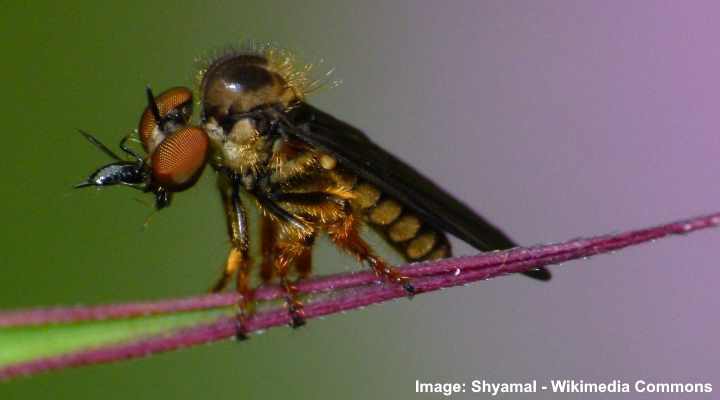
You may release beneficial predatory insects if you have a robber fly infestation in a greenhouse or garden. Thrips and their eggs and larvae are eaten by ladybugs, lacewings, and minute pirate bugs, for example. Ladybugs and other insects that feed on thrips might also be attracted to your plants. Fennel, dill, carpet bugleweed, marigolds, spearmint, spike speedwell, and stonecrops are some plants that attract thrip predators.
Pruning Can Help Get Rid of Thrips
To get rid of thrips from your plants, cut off infected leaves. To rid yourself of thrips, prune off and destroy just a few leaves with indications of a thrip infestation. In winter, cut off any galled and rolled leaves on your garden plants to eliminate the thrip eggs.
How to Prevent Thrips
Preventing thrips is more effective than trying to get rid of them. These annoying bugs have a lifecycle that allows them to reappear out of nowhere, just when you think you’ve gotten rid of them for good.
Inspect New Plants to Prevent Thrips in Your Home. Before bringing any new plants home, make sure to check for thrips on them. Don’t buy the plant if you see spots on the leaf undersides or when the leaves turn brown. It’s always a good idea to quarantine plants for two weeks, even if you believe the plant has no pest issues.
Regularly Check Plants for Thrips. The best way to avoid a large thrip invasion is to nip a thrip infestation in the bud. Checking houseplant leaves for indications of thrips is preferable to be a habit. Quickly isolate the plant from your other houseplants if you see dark green spots on the underside of leaves.
After that, bathe the diseased plant in an organic neem oil solution. You can also use yellow sticky traps to keep an eye on the thrip invasion near your other plants at the same time.
